#Raphael and La Fornarina
Explore tagged Tumblr posts
Photo
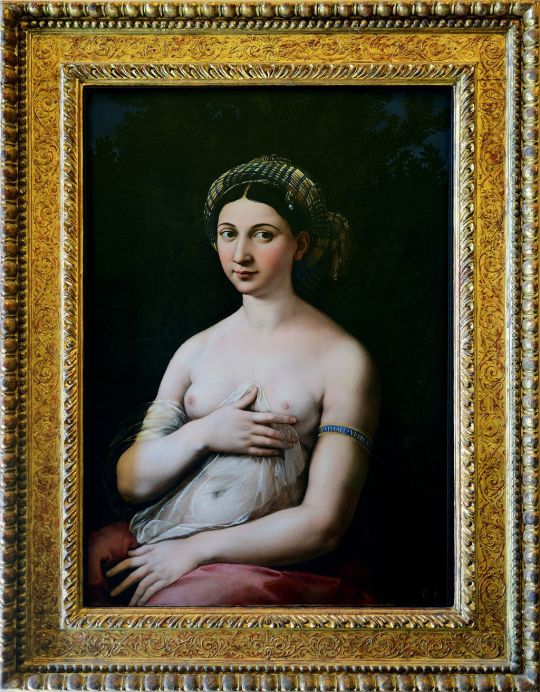
La Fornarina, Raphael, 1518-20
#la fornarina#raphael#1518#1519#1520#1510s#1520s#1500s#16th century#painting#portrait#art#renaissance#italian renaissance
111 notes
·
View notes
Text
whenever people get into discussions of whether or not there is a way to have an objective standard about what makes any kind of art "good art" (there isn't) I think we end up circling back to some kind of restatement of "Van Gogh barely sold any of his work when he was alive" or "Modigliani died penniless and his works now fetch some of the highest prices on the market"
which is true, and isn't without value, but I think more of how Raphael da Urbino (THAT Raphael) was considered the "Prince of Painters" during his lifetime and was arguably more favored than Michelangelo or in some eras Leonardo after his death, but has more recently fallen in estimation among many Early Modernist art historians, to the point where sure, he's still considered one of the three grand maestros of the Italian Renaissance, but he's by far considered the "most mid"
which I find incredibly fucked and wrong personally, BUT. it's still very much a thing; and I am sure that at some point in the next century or so, it won't be a thing, and we will have circled back to another point
anyway, in conclusion: the concept of what makes any work of art, regardless of the medium "good" is ever-changing, and while communities may reach (general) consensuses about certain works and artists, there will never be an objective way to verify what is good and what will be considered good in the canon forever and ever. INFLUENCE may last and be hard to debate--but shit, lol, you can see Raphael's influence on countless artists in years following his relatively short (comparatively) career, and he still gets a bit of a brush-off today.
#anyway this isn't just about painting it's something that happens in every art form#but it also gave me a good excuse to hand wring about raphael#two birds. one stone. i think la fornarina is breathtaking. fuck the haters.#FUCK VASARI!!!!#[the reason why i didn't pursue art history further academically is bc my summation of shit is like#'everyone hates raphael bc he pulled bitches. and they can't pull bitches.]
7 notes
·
View notes
Text

Raphael and La Fornarina (c. 1813-14)
By Jean-Auguste-Dominique Ingres, French
#Ingres#Raphael#la fornarina#napoleonic era#empire#French art#french empire#19th century#French#art#empire style#first french empire#Jean-Auguste-Dominique Ingres#Jean Auguste Dominique Ingres#19th century art#neoclassical art#neoclassical#neoclassicism#renaissance#rococco#baroque#renaissance art#pretty#paintings#painting#Raphael and La Fornarina#Napoleonic era art#fashion#fashion history
16 notes
·
View notes
Text

Torquato Fasso and Eleanore D'Este
Artist: Felice Schiavoni (Italian, 1803-1881)
Genre: Portrait
Date: 1839
Media: Oil on Canvas
Collection: Private Collection
Felice Schiavoni
Felice Schiavoni was an Italian painter, depicting history, genre, and portraits. During his early career, he often collaborated with his father, the painter Natale Schiavoni.
Felice was born in Trieste. He was first a pupil of his father, and he then studied at the Brera Academy at Milan, where he won a prize, and later at Venice and Vienna. He was awarded a prize and medal by Emperor Nicholas of Russia.
He often painted in Venice for Russian patrons. Among his works are a Death of Raphael Sanzio painted during a period of 15 years for Emperor Alexander II of Russia, and for which he was paid 60 thousand Lire. The large canvas was an scholarly tour-de-force which included 16 portraits of famous Italian artists, assembled to grieve at the bedside of the dying painter, including Pierin del Vago, La Fornarina, Giulio Romano, Andrea Navagero, Cardinal Pietro Bembo, Ludovico Ariosto, Michelangelo, and Benvenuto Cellini.
He also painted a Miracle of St. Anthony of Padua and a Saints Simon Stock and Anthony of Padua for a church in Trieste; a Raphael and the Fornarina for the Tosi Gallery, Venice ; a Cupid for the Brera Gallery in Milan; a Christ bearing the Cross ; a Christ Asleep; a Torquato Tasso reading to Eleonora; a Repose in Egypt (1824); a Venus and Cupid (1832); a Madonna (1854) ; a Raphael painting the Fornarina (1861); and a Holy Family (1864).
His wife, Regina Sfriza, died soon after Felice. His daughters Carolina and Julia were also painters, the former of landscapes, the latter of history and portraits. His brother Giovanni (1804–48) was also painter of mythology and history.
12 notes
·
View notes
Text

Jean Dominique Ingres Raphael et la Fornarina 1814
33 notes
·
View notes
Text

Raphael and the Fornarnia
Date: Jean-Auguste-Dominique Ingres (French, 1780–1867)
Genre: History
Date: 1814
Medium: Oil on Canvas
Collection: Harvard Art Museums, Boston, Massachusetts, United States
Depicted People:
Raphael
Margarita Luti
Description
This composition, the first of six versions, articulates Ingres’s conception of the art of painting. For him, the oeuvre of the Renaissance artist Raphael was the pinnacle of artistic achievement. Here Ingres draws on Raphael’s relationship with the woman known as “La Fornarina” (the Little Baker), which, according to the biographer Giorgio Vasari, led to the young artist’s death from an excess of lovemaking. Raphael has just sketched the famous portrait of her, and his beloved subject sits on his knee. But Raphael has eyes only for his own creation, which, like Ingres’s representation of its model, meets the viewer’s gaze. This triangle of glances is complicated by the presence of the Virgin in Raphael’s Madonna of the Chair, seen against the back wall, where she resembles the artist’s lover.
#portrait#raphael#jean auguste dominique ingres#lovers#studio#margarita luti#oil on canvas#french painter#european art#french culture#costume#canvas#chair#window#history
5 notes
·
View notes
Text

Title: Portrait of a Young Woman (or La Fornarina)
Artist: Raphael
Date: 1518
Style: High Renaissance
Genre: Portrait
47 notes
·
View notes
Text
a seta
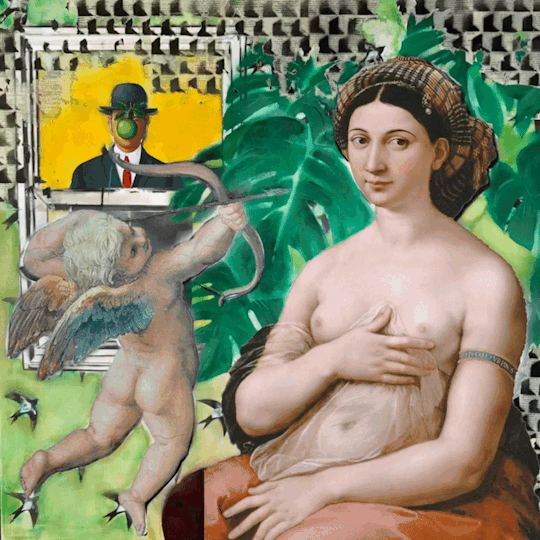
a seta, 2023 técnica mista s/tela [80x80]
.
the arrow, 2023 mixed media on canvas [80x80]

«seta. arma de arremesso constituída por meio de um arco que poderá ser usado para “ferir” a suscetibilidade de alguém. Associada à figura mitológica do Cupido, a seta, é um símbolo clássico que representa o amor, a paixão e o desejo. A seta, quando lançada, tinha o efeito de despertar o amor e o desejo naqueles que por ela atingidos.» in Magriço (2023) Elucidário de Palavras e Afins
.
«arrow. a throwing weapon consisting of a bow that can be used to ‘wound’ someone’s susceptibility. Associated with the mythological figure of Cupid, the arrow is a classic symbol representing love, passion, and desire. When released, the arrow had the effect of arousing love and desire in those it struck.» in Magriço (2023) Eliucidary off words and related

fusão de elementos clássicos «"La fornarina"e “El triunfo de Galatea” de Raphael» e surreais «Le fils de l'homme de René Magritte» num estudo sobre o amor, o desejo, a tentação.

#magriço#quadrosvivos#contemporaryart#artcollector#artcollection#artdiscover#artinvestment#buyart#curator#design#emergingartist#emergingart#figurativepainting#fineart#pictorialwork#Ribatejo#portugueseartist#portugal#visualart#rené magritte#raphael#la fornarina#El triunfo de Galatea#Les fils de l' homme
2 notes
·
View notes
Photo
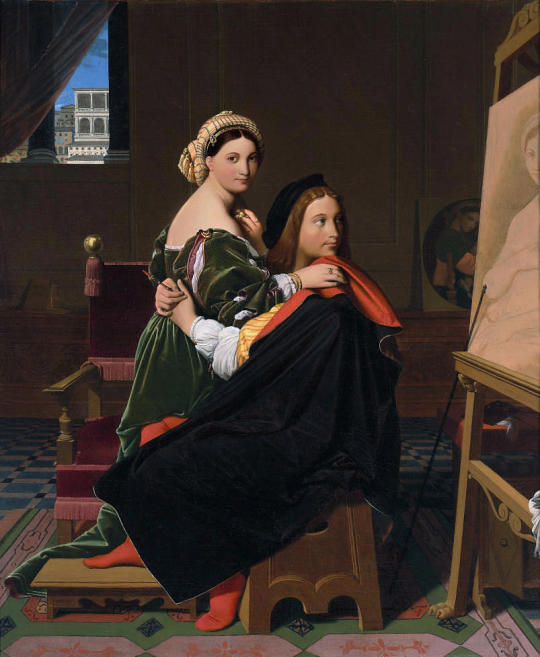
MWW Artwork of the Day (1/12/23) Jean-Auguste-Dominique Ingres (French, 1780-1867) Raphael and the Fornarina (1814) Oil on canvas, 64.8 x 53.3 cm. Harvard Art Museums/Fogg Museum, Cambridge MA (Grenville L. Winthrop Bequest)
This composition, the first of six versions, articulates Ingres’s conception of the art of painting. For him, the oeuvre of the Renaissance artist Raphael was the pinnacle of artistic achievement. Here Ingres draws on Raphael’s relationship with the woman known as “La Fornarina” (the Little Baker), which, according to the biographer Giorgio Vasari, led to the young artist’s death from an excess of lovemaking. Raphael has just sketched the famous portrait of her, and his beloved subject sits on his knee. But Raphael has eyes only for his own creation, which, like Ingres’s representation of its model, meets the viewer’s gaze. This triangle of glances is complicated by the presence of the Virgin in Raphael’s "Madonna of the Chair," seen against the back wall, where she resembles the artist’s lover.
Ingres is one of the featured artists in this MWW gallery/album: https://www.facebook.com/media/set/?set=a.727184920720213&type=3
16 notes
·
View notes
Text
7.2 Research Paper Summary
One of the primary cultural symbols that is present in art is gender signs, or the specific ways in which masculinity and femininity are understood and exemplified in the historical context of a work. While these specific signs are usually tied to the idealized understanding of masculinity and femininity within a culture, the signs are just representations of qualities that can then be used to subvert the typical message of the signs. In their article “Performative Acts and Gender Constitution: An Essay in Phenomenology and Feminist Theory,” Judith Butler asserts that “gender is in no way a stable identity or locos of agency from which various acts proceed” rather that gender is an identity connected to time and “instituted through a stylized repetition of acts” (519). In this way gender signs and signifiers are tied to an idea of performance, adopting the specific signs that represent what one wants to signify as well as establishing a baseline from which to subvert the meanings of the signs and signifying a subversion of gender performance. This idea of gender subversion through the use of gendered signs within art is most prominent in Artemisia Gentilischi’s Judith Slaying Holofernes (figure 1) and Cindy Sherman’s Untitled #205 (figure 2).

Figure 1, Judith Slaying Holofernes, Artemisia Gentileshci, oil on canvas, 1612-13, Pitti collection.

Figure 2, Untitled #205, Cindy Sherman, chromogenic color print, 1989.
The rest of my paper is about analyzing the performative nature of Gentileschi and Sherman’s depiction of femininity in comparison with Caravaggio’s Judith Beheading Holofernes, Orazio Gentileschi’s Judith and Her Maidservant with the Head of Holofernes, and Raphael’s La Fornarina. I also analyze the performative nature of Caravaggio, Orazio, and Raphael’s idealized femininity as a counter to the subversion of societal norms present in Gentileschi and Sherman’s pieces.
0 notes
Text
kinda wild to me that there have been so few like... legit historical romance novels with artist heroes who actually fuck HARD
(Eggs Benny does not count)
Like the sensuality of La Fornarina, Raphael's signature being written into the band circling his naked mistress's arm; L'Origine du Monde, and Courbet and Whistler possibly falling out because Courbet MAYBE painted Whistler's mistress's pussy like that and MAYBE fucked her; the lushness of Bocca Baciata and Rossetti's tendency to fall in love with super good artist's models.
There ARE exceptions (like Lady Isabella's Scandalous Marriage) but dude a lot of attempts are... ruff...
8 notes
·
View notes
Text

Torquato Fasso and Eleanore D'Este
Artist: Felice Schiavoni (Italian, 1803-1881)
Genre: Portrait
Date: 1839
Media: Oil on Canvas
Collection: Private Collection
Felice Schiavoni
Felice Schiavoni was an Italian painter, depicting history, genre, and portraits. During his early career, he often collaborated with his father, the painter Natale Schiavoni.
Felice was born in Trieste. He was first a pupil of his father, and he then studied at the Brera Academy at Milan, where he won a prize, and later at Venice and Vienna. He was awarded a prize and medal by Emperor Nicholas of Russia.
He often painted in Venice for Russian patrons. Among his works are a Death of Raphael Sanzio painted during a period of 15 years for Emperor Alexander II of Russia, and for which he was paid 60 thousand Lire. The large canvas was an scholarly tour-de-force which included 16 portraits of famous Italian artists, assembled to grieve at the bedside of the dying painter, including Pierin del Vago, La Fornarina, Giulio Romano, Andrea Navagero, Cardinal Pietro Bembo, Ludovico Ariosto, Michelangelo, and Benvenuto Cellini.
He also painted a Miracle of St. Anthony of Padua and a Saints Simon Stock and Anthony of Padua for a church in Trieste; a Raphael and the Fornarina for the Tosi Gallery, Venice ; a Cupid for the Brera Gallery in Milan; a Christ bearing the Cross ; a Christ Asleep; a Torquato Tasso reading to Eleonora; a Repose in Egypt (1824); a Venus and Cupid (1832); a Madonna (1854) ; a Raphael painting the Fornarina (1861); and a Holy Family (1864).
His wife, Regina Sfriza, died soon after Felice. His daughters Carolina and Julia were also painters, the former of landscapes, the latter of history and portraits. His brother Giovanni (1804–48) was also painter of mythology and history.
0 notes
Text
Baring It All: Breasts Take Center Stage At This Major Exhibition
— By Jacqui Palumbo | Monday April 22, 2024
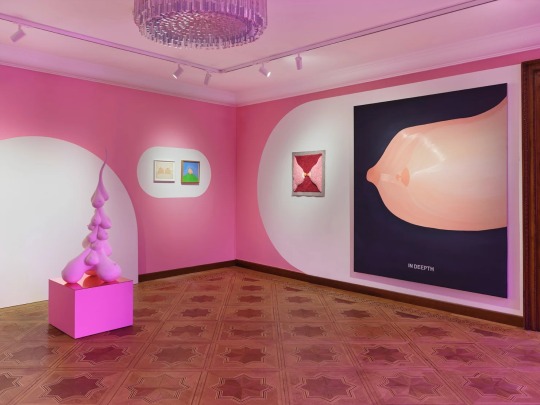
"Breasts" runs from April to November at the 60th Venice Biennale international art exhibition. Eva Herzog
(CNN) — What is one of the earliest and enduring subjects in art and media — as well as one of the most censored? Breasts. First carved large onto small “Venus” figurines some 25,000 years ago as totems of fertility, they’re now seen (or hidden) as a potent symbol of desire, motherhood, feminism, sexism, beauty ideals, defiance, controversy or illness, depending on context.
And these are all themes explored broadly in the exhibition “Breasts,” a robust survey on display at the 60th Venice Bienniale. Hosted at the Palazzo Franchetti, the show includes artworks by household names such as Cindy Sherman, Robert Mapplethorpe and Salvador Dalí, as well as early-career artists including Anna Weyant, Chloe Wise and Lakin Ogunbanwo. Divided into five rooms against the building’s art deco designs, the artworks are meant to be in conversation with one another — and with exhibition-goers — according to the show’s curator Carolina Pasti.
“It’s very intimate, so it’s perfect for international artists to develop a dialogue with each other,” she said in a video call.
One of the first juxtapositions visitors encounter is between the exhibition’s earliest work, an early 16th-century Madonna and child by Bernardino del Signoraccio, and a self-portrait by Sherman which depicts the artist draped in prosthetic breasts and a pregnant belly. Both images of motherhood feature exaggerated anatomy — the baby Jesus in Del Signoraccio’s panel painting exposing his mother’s rigid bosom, while Sherman displays a hyperreal silicone torso in her riff on the Raphael painting “La Fornarina” — and sets the stage by showing how Renaissance artists have continued to influence our attitudes around breasts today.
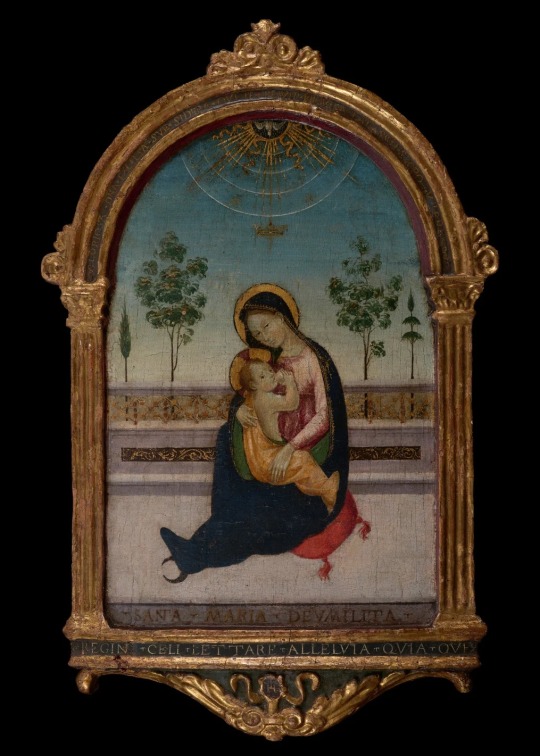
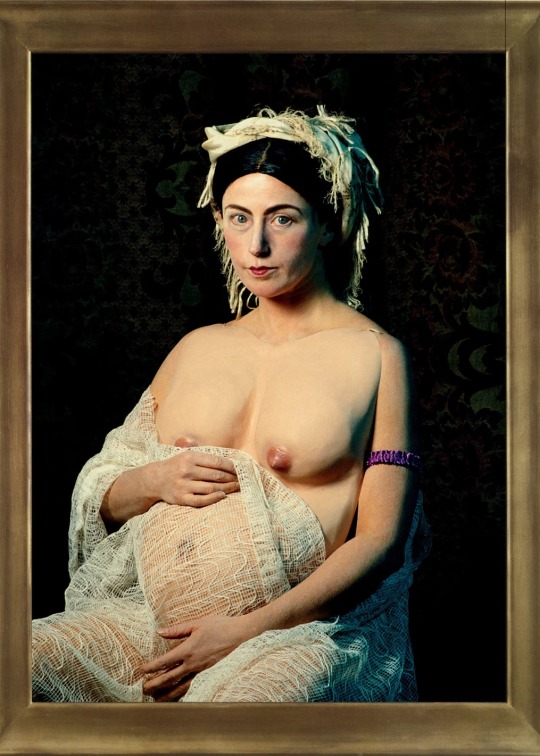
Left: Bernardino del Signoraccio, "Madonna dell' Umiltà," ca. 1460-1540 Courtesy Flavio Gianassi/FG Fine Arts Ltd. Right: Cindy Sherman, "Untitled 205," 1989 Cindy Sherman
From there, the show winds through painting, sculpture and design, photography, commercial advertising and video art, exploring the ways that breasts have been seen and represented through both the male and female gazes.
“It goes back to cave paintings — we’ve always been fascinated with the human form, and particularly the female form, which has this incredible allure and mystery,” said the artist Teniqua Crawford, who is exhibiting a delicate rendering of the breast as landscape. “Artists keep going back to it.”
“It’s been a wonderful moment to contemplate my own relationship with the meaning of breasts,” she added of the show.
“Breasts” was staged, in part, to promote breast cancer awareness, and marks a partnership with the medical research non-profit Fondazione IEO-MONZINO, which will receive a portion of its catalog sales. It’s a theme apparent throughout the show, with a vivid pink staging and backdrops inspired by the color of the cause. That includes a passageway designed by Buchanan Studio, “Booby Trap” which is draped in pink fabric and features 35 anatomical lights from above.
And the opening night treats? All according to the theme, of course, with suggestively shaped chocolate bon bons and burrata.
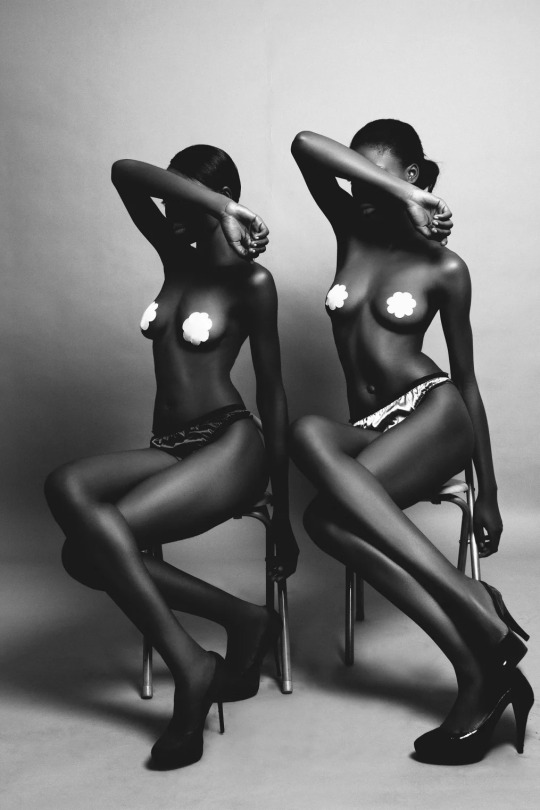
Lakin Ogunbanwo "Untitled (2 girls)," 2013 Courtesy Whatiftheworld
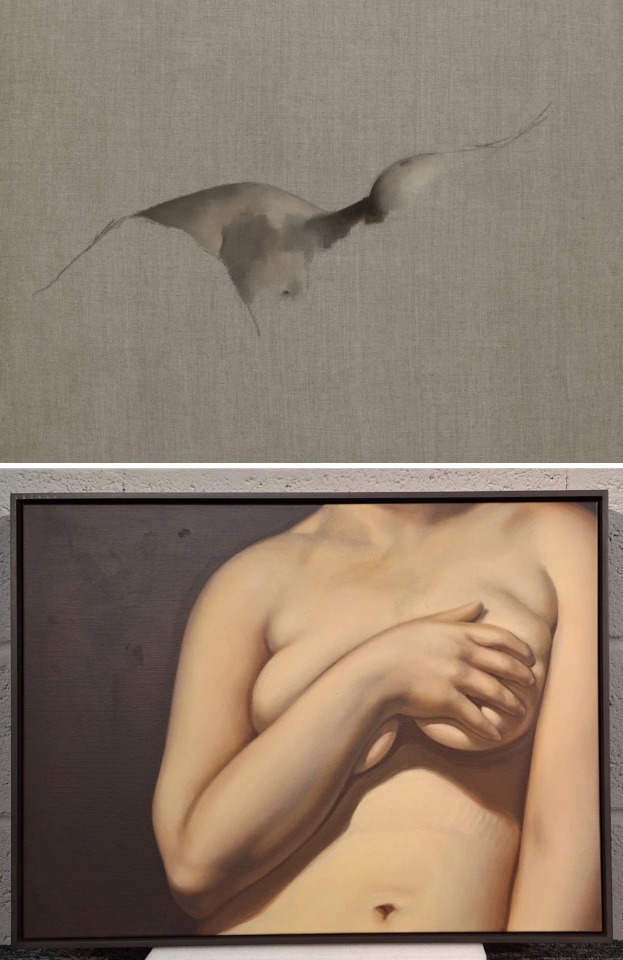
Top: Teniqua Crawford, "Fragment Horizon," 2024 Todd White Bottom: Anna Weyant, "Chest," 2020 Courtesy private collection, Europe
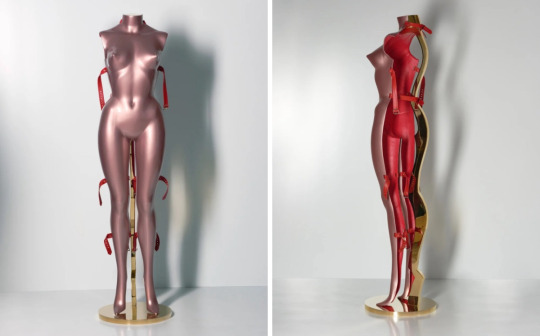
Left: Allen Jones, "Cover Story," 2015 Courtesy the artist/Galleria d'Arte Maggiore Right: Allen Jones, "Cover Story," 2015 Courtesy the artist/Galleria d'Arte Maggiore
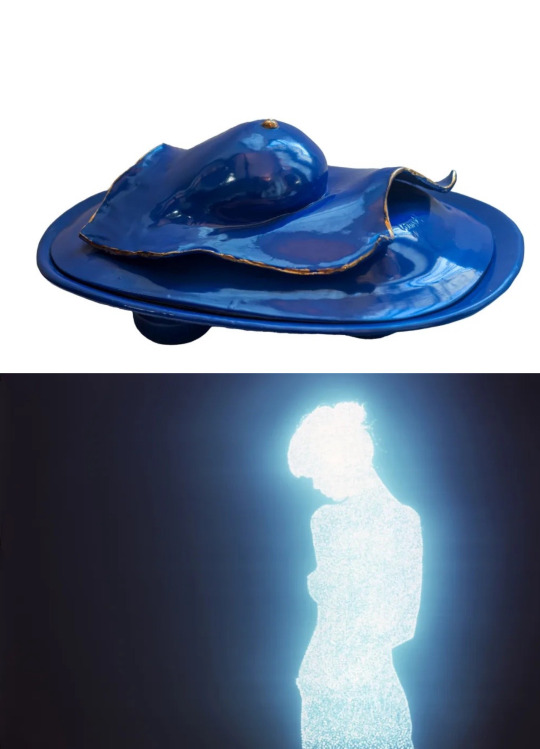
Top: Laura Panno, "Alfabeto del corpo (Ceramica Blu)," 1990 Courtesy the Artist Bottom: Christopher Bucklow "Tetrarch (Claudia-Schiffer)", 2010 Christopher Bucklow
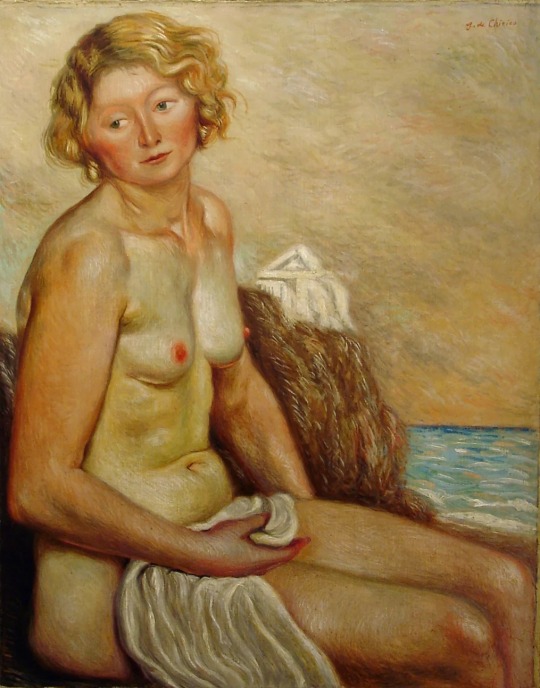
Giorgio de Chirico "Nudo di donna," 1930 Courtesy private collection, Turin
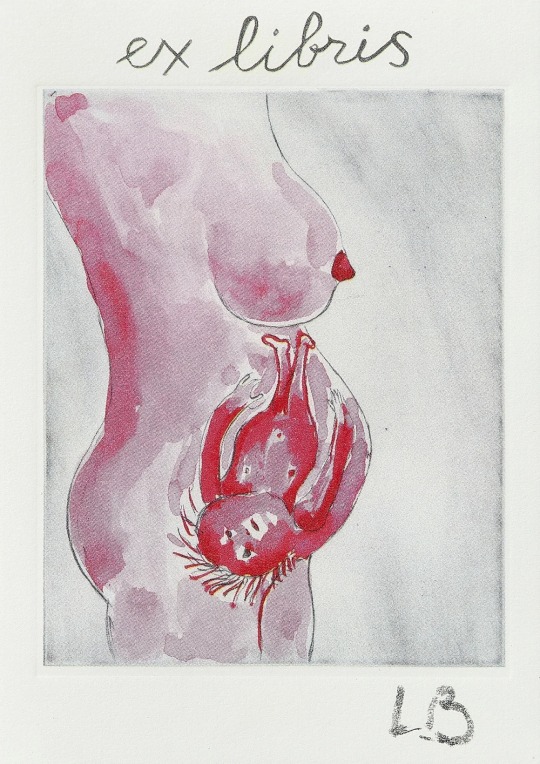
Louise Bourgeois "The-Reticent Child," 2005 Courtesy private collection, Italy
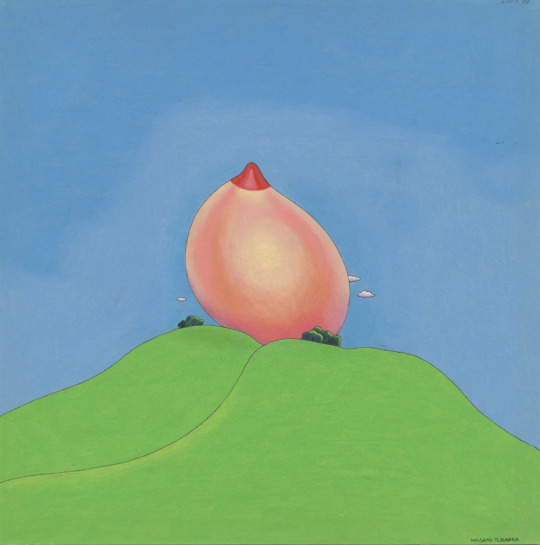
Masami Teraoka, "Breast on Hollywood Hills Installation Project," 1970 Courtesy Catherine Clark Gallery
1 note
·
View note
Text
Ancient Art
Today we visited the Museum of Ancient Art in the Barberini Palace. I have to admit that I enjoy the palaces as much as the art…maybe more.
This 17th century palace was built by Maffeo Barberini who became Pope Urban VIII. Three architects worked on the design, two of whom are favorites of mine, Bernini and his arch-rival Borromini. The rivalry plays out in the palace which has two grand staircases, each designed by one of the rivals.
Today the palace hosts a museum of art, mostly pre 1800. The art is arranged chronologically and well curated in both Italian and English. The palace itself is spectacular.

The front of the palace.


The Borromini staircase is rectangular, while the Bernini stairway is circular.

There are only a few sculptures. This one by Corradini of The Veiled Vestal Tuccia is especially cool. The veil, though marble, looks like a translucent cover over her.

This Raphael, La Fornarina, was the most recognizable to me.


There are a number of busts by my pal Bernini. The subjects (popes) are not very interesting, but the details of the carvings are amazing.

This school schedule means we finish all of our visits after dark. That’s not so great for our step-counts, but does make for some nice photos.
1 note
·
View note
Text

Balzac referencing this painting, La Fornarina by Raphael, as what happens to poets, those “great little men,” who love the baker’s wife (a commoner whom they see the world in and also have no business loving) with all the beauty and passion the world has to offer; I imagine the joke is that they gaze lovingly into the mirror, at their own work (at best, “look how well I captured!”). Then, Balzac continues, they love these women all too fervently — so they die in their arms (of heartache)— all this for the very romantic love affair between Lucien and Esther, lmao lmao am I making this up or is Balzac being completely ironic and an asshole, god I love him.
He also says, “the power to desire [and] to conceive…is perhaps the same thing” which is, I think, my entire feminism/love phd, but he’s already brought it to its conclusion and flippantly throws it out as a single clause in some random paragraph! My life’s work!!!
Wait! Update! Lol!!! This isn’t La Fornarina by Raphael, this painting is “La Fornarina and Raphael” by Ingres!
THIS is La Fornarina! Oh the drama

0 notes
Text
Joel Peter Witkin

Night in a Small Town, New Mexico, 2007

The Sins of Joan Miro, New Mexico, 1981

Raphael & La Fornarina, 2003

The inimitable and always disturbing Joel Peter Witkin. Ph by Roger Ressmeyer
0 notes